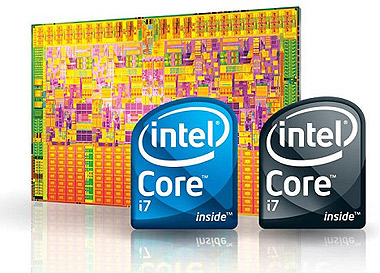When it comes to choosing between Intel and AMD, the folks with the most at stake are the power user crowd.
Professional PC systems are used for 3D-rendering, video processing, audio engineering, CAD,
photo editing and intensive content creation work. These are
the applications that demand raw processing power - Microsoft Office, email and
web browsers can be handled with much slower processors.
Quad-core processors
were designed for power users, and the choice between AMD or Intel isn't quite as
straightforward as the previous two categories I've talked about today. The easy way
out would be to say the choice comes down to Intel's Core 2
Quad Q9770 or AMD's quad-core Phenom X4 9950 processor.... but
that would be the wrong answer, particularly after you've just dropped two
grand.
You
see, there's a new architecture in town, and it's spoiling for a fight.
Codenamed 'Nehalem', the Core i7 processor is Intel's newest microprocessor
architecture, and the first from Intel to integrate the memory controller on
chip.
The new architecture means simple upgrades are a thing of the past. The
Intel Core i7 has switched to a new LGA 1366-pin socket, meaning entirely
new motherboards and thermal solutions are necessary. It also uses
triple-channel DDR3 memory, though in a pinch you can apparently get away with old dual-channel
DDR3 stock. It's the same sort of fundamental change experienced when users
upgraded from Intel's socket 478 to the current family of socket 775
processors.
 The performance gains, however, make all this
potential upheaval in hardware well worth it. In quad-core friendly
benchmarks, like Maxon 4D's Cinebench, the 3.6GHz Core i7 965 process shows a 35%
performance increase over the 3.6GHz Core 2 Quad Q9775.
The performance gains, however, make all this
potential upheaval in hardware well worth it. In quad-core friendly
benchmarks, like Maxon 4D's Cinebench, the 3.6GHz Core i7 965 process shows a 35%
performance increase over the 3.6GHz Core 2 Quad Q9775.
Clock for
clock, Core i7 processors will give better performance than a Core 2
Quad processors, with the most dramatic gains in 3D rendering, media
encoding, and heavily multi-threaded software. The Core i7 is also
specified to eventually reach speeds of up to 4GHz, ensuring a long and fruitful
upgrade path for at least the next three years.
The first round of Intel Core
i7 processors to launch in Q4'08 were the Core i7 965 (3.2GHz), Core i7 940 (2.93GHz)
and Core i7 920 (2.66GHz). Mainstream Core i7 processors will follow in the
first quarter of 2009, at significantly more economical price points than the
initial $1200 price tag the Core i7 965 commands.
With new CPU
architecture on the
ground there's not much point in dropping lots of money on a Core 2
Quad system now. Even if you're not interested in swapping out 75% of your existing hardware
for the pleasure of running a socket 1366 chip - the Core i7 launch should
likely drop the price on current Core 2 Quad processors. Being patient is the
best advice we can give you now… but hold that thought, let's quickly look at
what AMD has to offer.
AMD, meanwhile, hasn't been completely left out in the cold. Its fastest
Phenom X4 processors are struggling to keep up with Intel's midrange parts,
however compared to previous AMD chips are much faster. AMD's socket AM2 Phenom
X4 9950 BE ($250 CDN) can provide performance that varies between Intel's Core 2
Quad Q6600 for ($240) and the Q9300 ($330), depending on the specific rendering
or media encoding benchmarks used. However, AMD's chips are still based on a
65nm process, which means they draw a bit more power and generate higher
temperatures.
AMD also has a new socket on the horizon, called AM3. The new AM3 processors,
which are expected some time in 2009, will still work in their current AM2+
socket motherboards, but the new AM3 motherboards won't support current AM2
CPUs. While I'd love to be proven wrong, I suspect that AM3 still won't be
competing equally with Intel's Core i7 performance once both technologies are
widely available.
Thus, with both Intel and AMD
in the midst of a socket change, the best solution for a high-power computer
user is neither. Don't buy an Intel Core 2 Quad even though it is faster than an
AMD Phenom X4. Don't buy an AMD Phenom X4 because, well, the Intel
solution is better. Instead, look towards the socket 1366 Intel Core i7 CPU hitting
the retail channel near you.
If you can't be patient for a Core i7 and Intel X58
motherboard based workstation, then I suppose my money's on the Intel Core 2
Quad Q9300. For roughly $330 CDN this socket 775 processor offers excellent
media encoding and number crunching application performance, improving on the
Q6600, while avoiding the price inflation found on the faster Yorkfield Intel
Core 2 Quad processors. The array of socket 775 supporting chipsets isn't going
to expand much further, but the lifespan will be solid for at least another two
years. It's legacy technology, but legacy with life insurance.
